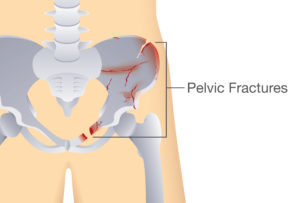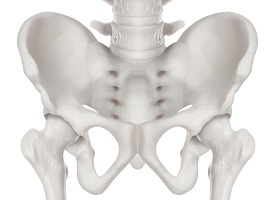Pelvic Injuries most commonly occur when the pelvis undergoes trauma. The pelvis is the large bone which sits at the base of the spine and is the site of the ball-and-socket joints of both legs. Common causes of pelvic injury include car crashes and falls from great heights. In car crashes, people tend to hit the clutch and the brake pedal, one with each leg. This locks the legs in a straight line and the force from the impact occurs travels up the legs and to the hip joints. All of that initial impact and pressure has to be dissipated somewhere.
The pelvis is, like a polo mint, a circle, meaning it will nearly always break in two places. If you drop a polo on the floor, it doesn’t crack in one place, it will always break in two. The pelvis is the same. It can break in multiple places, but it never breaks in just one.
The Injury Itself
The first and weakest point is over the pubis. This is where the pelvis sits over the bladder. It is the narrowest, thinnest and most delicate area of the pelvis. Since the pubis is most liable to damage and it sits over the bladder, pelvic injuries quite often cause bladder injuries as well. This can create septicaemia or peritonitis so all efforts must be made to sustain infection control.

Pelvic fractures can also occur, due to both the size of the bone and of the complexity of the injury itself. This is where the large faces of the pelvis become cracked/fractured. Pelvic fractures often have quite a high mortality. When the pelvis is fractured, the patient will not be able to walk. This means they are bedbound and putting them at more risk to things like bedsores and pneumonia. Depending on the severity, it may need surgical repair. Consequently, the patient is put through the operating theatre where complications may arise. So NEVER think of a pelvic injury as something quite minor. Pelvis injuries are a major trauma and have to be dealt with properly and swiftly to prevent deterioration.
The other areas it tends to break is through the joint itself to the right or left of the pubis bone. It sometimes actually shatters through the back as well, where the spine joins the pelvis. This is a very serious injury since not only is the pelvis affected, but the spine is as well.
Stabilizing the Casualty
Because it is a big bone, any movement causes a large cavity to form around it. This means blood will flow into this cavity and the abdomen will start to swell. Therefore you need to give the bone some stability so there is no flexibility in the pelvis at all. To do this you can use a pelvic sling. If you move the casualty before stabilising the pelvis, you can rupture the bladder and blood vessels and cause arterial bleeds. This makes the problem ten times worse than it was when you arrived, which is completely the opposite idea of First Aid.
All incidents will be different. For example, all car crashes you arrive at will be different. Instantly, you can see from the position they are sitting in the car, if they are even still in the car, what sort of injuries the casualty will have sustained. Side impacts tend to hit the pelvis from the side with the inside of the door panel hitting the person’s pelvis. Rear impacts tend to not do so much damage to the pelvis because most people have the handbrake on and their feet off of the pedals. This means that the legs are not locked in a rigid position, creating the problem to the pelvis itself.
Signs and Symptoms
The most obvious sign of any serious trauma to the pelvis will be that the casualty is in a lot of pain. The pain is intense. The patient will tell you their hips or pelvis are in absolute agony. Another sign can be a loss of fluids. Patients can become incontinent if the bladder becomes damaged or the control of the bladder sphincter is lost. The presentation of the legs of the casualty could also be a sign of pelvic injuries. The upper leg muscles attach to the pelvis itself, so the presentation of the legs may not be entirely normal. With a pelvic fracture, the casualty will lose control of their leg muscles, so almost certainly, the patient will not be able to move their lower limbs at all. The presentation of the feet would, therefore, be floppy and flat since there would be no movement from them. A symptom may be that the casualty tells you that it feels like the pelvis feels open, or they felt it open but now cannot feel it.
Remember, pelvic injuries are life-threatening and need to be dealt with properly before moving the casualty. Should you suspect a pelvic injury, make sure that the Emergency Services are on their way.
For more information on training courses, visit our “Courses” page which also includes our First Responder and First Person on Scene (FPOS) Courses.


Pingback: Asthma a common life-threatening condition thats severity is often missed
Pingback: Joint examination is the basic examination of any joint.
Pingback: Forestry First Aid at Work Training courses to comply with HSE
Pingback: Adult fractures - First Aid Wiki
Pingback: Parkinson's Disease